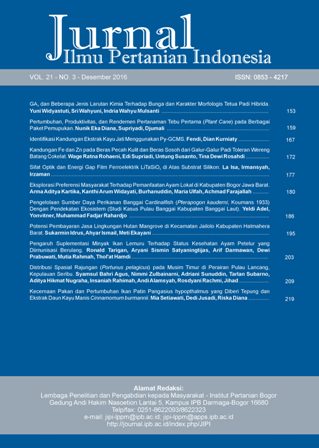Kandungan Fe dan Zn pada Beras Pecah Kulit dan Beras Sosoh dari Galur-Galur Padi Toleran Wereng Batang Cokelat
Abstract
In addition to carbohydrates, rice contains other minerals that function to growth and development of vital human organs. On the other hand, the content is influenced by genetic and milling processes. Indonesian Centre of Rice Research (ICRR) has genetic collection resistant to strains of the brown plant hopper (BPH). Genotypes were studied to assemble the pest-resistant varieties with high iron (Fe) and zinc (Zn) content. This study aims to determine the BPH-resistant lines that had high and stable Fe and or Zn content. The study was conducted in XRF Laboratory, ICRR Sukamandi, West Java in 2015. Fe and Zn were determined by using XRF machine with a system of performance-based X-ray. Total 20 rice lines that resistant to BPH was used Fe and Zn content on brown and polished rice were evaluated duplo. The results showed that milling generally decreased the content of Fe and Zn at rate 56.31% and 20.54%, respectively. The highest Fe content was found in BP19564b-WBC-1-1-4-3 (12.25 ppm), while the highest Zn content in BP19564b-WBC-1-9-8-3 (26.35 ppm). Genotype BP19564b-WBC-1-9-4-2 and BP19564b-WBC-1-9-8-3 exhibited the lowest in reduction Fe and Zn content, respective, from brown to polished rice.Downloads
References
Aggett PJ, Comerford JG. 1995. Zinc and human health. Nutrition Reviews. 53(9): S16-S22.
Bouis HE, Graham RD, Welch RM. 2000. The Consultative Group on International Agricultural Research (CGIAR) Micronutrients Project: justification and objectives. Food and Nutrition. 21(4): 374-381. http://doi.org/bwd4
Dianawati N, Sugiarso RD. 2015. Penentuan Kadar Besi Selama Fase Pematangan Padi Menggunakan Spektrofotometer UV-Vis. Jurnal Sains dan Seni ITS. 4(2): 35-38.
Hidayat A.1999. Zink: Esensial Bagi Kesehatan. Jurnal Kedokteran Trisakti. 18(1): 19-27.
Indrasari SD. 2006a. Kandungan mineral padi varietas unggul dan kaitannya dengan kesehatan. Iptek Tanaman Pangan. 1(1): 88-99.
Indrasari SD. 2006b. Kandungan besi varietas padi. Warta Penelitian dan Pengembangan Pertanian. 28(6): 13-14.
Indrasari SD, Wibowo P, Daradjat AA. 2008. Kandungan mineral beras varietas unggul baru. In: Prosiding Seminar Nasional BB Padi 2008: 1457-1472. BMJ [Internet]. [diunduh 5 Des 2016]. Tersedia pada http://www.litbang.pertanian.go.id/special/padi/bbpadi_2008_prosb412.pdf.
Iswari SD, Suardi D, Ridwan I. 2010. Galur Padi Beras Hitam Hasil Kultur Antera. [diunduh 15 Februari 2016]. Tersedia pada http:// pustaka.litbang.pertanian.go.id/inovasi/kl10093.pdf
Juslina, Thaha AR, Virani D. 2013. Asupan Zat Besi (Fe) dan Hubungannya dengan Jenis Anemia pada Wanita Prakonsepsi di Kecamatan Ujung Tanah dan Kecamatan Biringkanaya Kota Makassar. Makassar (ID): Universitas Hasanuddin.
Liyanan, Septianingrum E, Kusbiantoro B. 2015. Kandungan unsur mineral seng (Zn), bioavailabilitas dan biofortifikasinya dalam beras. Jurnal Sungkai. 3(2): 65-73.
Mohapatra D, Bal S. 2007. Effect of degree of milling on speci Energy consumtion, optical measurement and cooking quality. Journal of Food Engineering. 80(1): 119-125. http://doi.org/bkv6v5
Mulyaningsih TR. 2009. Kandungan unsur Fe dan Zn dalam bahan pangan produk pertanian, peternakan dan perikanan dengan metode k0-AANI. Jurnal Sains dan Teknologi Nuklir Indonesia. 10(2): 71-80.
Munihal A, Sudono, Krisdinamurtirin, Husaini, Sugih R, Khumaida M. 1989. Angka kecukupan gizi rata-rata yang dianjurkan (AKG). Widyakarya Pangan dan Gizi. Jakarta (ID): Lembaga Ilmu Pengetahuan Indonesia.
Payakapol L, Moongngarm A, Daomukda N, Noisuwan A. 2011. Influence of Degree of Milling on Chemical Compositions and Physicochemical Properties of Jasmine Rice. In: 2010 International Conference on Biology, Environment and Chemistry. Singapore (SG). IPCBEE. 1: 84-86.
Welch RM, Graham RD. 2004. Breeding for micronutrients in staple food crops from a human nutrition perspective. Journal of Experimental Botany. 55(396): 353-364. http://doi.org/chkmwt
Yora M, Wahyuni S, Akhiar AA. 2013. Evaluasi Kandungan Besi (Fe) dan Zink (Zn) Pada Beberapa Kultivar Padi Beras Merah Asal Sumatera Barat. Dalam: Prosiding Seminar Hari Pangan Sedunia Ke-33. Optimalisasi Sumber Daya Lokal Melalui Diversifikasi Pangan Menuju Kemandirian Pangan dan Perbaikan Gizi Masyarakat Menyongsong Masyarakat Ekonomi ASEAN 2015. Padang. Sumatera Barat (ID), 21-22 Oktober 2013.
Yustisia, Tohari, Shiddieq Dj, Subowo. 2012. Pengkayaan Besi (Fe) dan Seng (Zn) dalam Beras dan Karakter Penentu Varietas Padi Sawah Efisien pada Tanah Vertisol dan Inseptisol. Agrotop: Journal on Agriculture Science. 2(1): 67-75.
This journal is published under the terms of the Creative Commons Attribution-NonCommercial 4.0 International License. Authors who publish with this journal agree to the following terms: Authors retain copyright and grant the journal right of first publication with the work simultaneously licensed under a Creative Commons Attribution-NonCommercial 4.0 International License. Attribution — You must give appropriate credit, provide a link to the license, and indicate if changes were made. You may do so in any reasonable manner, but not in any way that suggests the licensor endorses you or your use. NonCommercial — You may not use the material for commercial purposes.






















